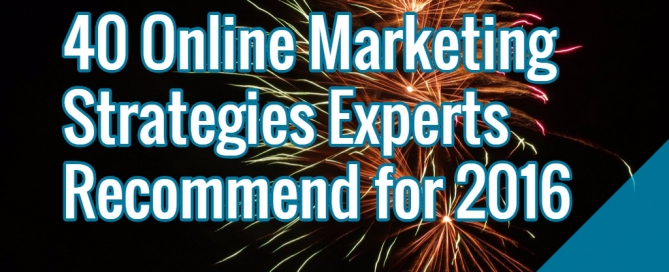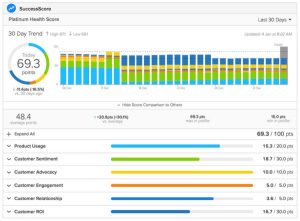
Every company is starting to prepare for 2016 now and with that they are looking for marketing strategies they can take into the New Year to increase their profits.
On behalf of Search Engine People, I asked 40 online marketing experts from across the globe to get their advice on what business owners should be focusing on next year.
Here are the responses I got:
 Murray Newlands – Entrepreneur, and blogger for Forbes, Inc., Mashable, and more
Murray Newlands – Entrepreneur, and blogger for Forbes, Inc., Mashable, and more
Content marketing has exploded in the last couple of years and in order to stand out from the pack marketers are increasingly turning to influencers to get ahead. Influencers are great at taking a simple message and packaging it to resonate with a target audience. Having created the right content influencers are adept at ensuring it reaches the right audience.
Check out Murray’s motivational quotes at: https://vine.co/Murray.Newlands
 John Boitnott – Digital Consultant
John Boitnott – Digital Consultant
For 2016, it will be increasingly important to differentiate your content from the rest of the crowd by truly addressing needs and desires expressed by your readership or your actual customers, on an ongoing basis. This means monitoring very closely what your current customers have to say, and tailoring your content to those concerns.
 Larry Kim – Founder of WordStream
Larry Kim – Founder of WordStream
The single most important thing you must do in 2016 is to use more emojis in your blog content, social media updates and PPC ads. I’m also excited about Facebook/Instagram ads and jumping on the mobile app bandwagon!
 Kristi Hines – Freelance Writer
Kristi Hines – Freelance Writer
To get your marketing off to a good start in 2016, I would suggest giving your top online presences a once-over. In particular, make sure everything is consistent: profile images, cover photos, calls to action, taglines, and bios. This is applicable for everything from your blog to your Yelp listing.
From there, review your analytics to see what traffic sources generated the most conversions for your business in 2015 so you know what marketing strategies to focus on for 2016.
Not tracking conversions? Then your goal is to set up conversion goals in Google Analytics so you can do this for next year.
 Zac Johnson of http://blogging.org
Zac Johnson of http://blogging.org
In 2016, the focus should still be on growing your own brand and following and not just providing leads to others. Sure, this sounds easy enough, but in a competitive market it’s anything but. To help establish your brand, focus on creating original content that can be shared and linked to by others within your industry. This can be infographic, expert roundups and detailed guides. No matter what it is, make sure it’s better than what’s currently out there and make sure to put in the necessary content promotion after it goes live.
 Bill Belew – Influence Marketing Doer & Trainer
Bill Belew – Influence Marketing Doer & Trainer
It’s not about who you know in your niche. It’s about who knows you. The research data doesn’t lie. It’s cheaper, easier and more time efficient for people to find you than for you to find them. Master the art of acquiring organic search. Serve up quality content to your target audience online = publish information that will make heroes of your readers to their audience. Serve your readers well and you will be their person of influence. You will be sought out. You are my hero. I serve you. Who’s your hero?
 Lukasz Zelezny – Head of Organic Acquisition at uSwitch.com
Lukasz Zelezny – Head of Organic Acquisition at uSwitch.com
As 2015 is rapidly winding down to a close, it’s time to start thinking about your marketing strategies that will usher in the New Year. Since we have seen some pretty important changes in the way Google is ranking websites, I am of the firm belief that it is time to take a good, hard look at those changes and act accordingly if there is any hope of staying competitive in a market that has, for the most part, gone mobile.
Out with the Old
During the latter part of 2014 and in the first few months of 2015, there was a huge amount of concern in regards to Google’s intent on updating their search algorithms to cater to mobile users. There was, in fact, so much worry over the announced changes that users around the Web began calling this ‘Mobilegeddon,’ something to fear. Yes, Mobilegeddon did announce the end of an era but the new generation of search engine marketing is really not all that frightening. It’s only a matter of looking at how people are searching for the information they need.
In with the New
In short, Mobilegeddon was all about ensuring that consumers using mobile devices could have as good a user experience as those searching from desktop computers. Google found that all predictions had come to pass and mobile searches had overtaken desktop searches, but many sites were not mobile friendly. Mobilegeddon was instituted so that websites that couldn’t be viewed well on mobile devices wouldn’t get listed in the SERPs, Search Engine Results Pages. It’s a logical progression on the part of Google and not some fearful end-of-the-search-marketing world many had feared.
A New Focus for 2016
What I am suggesting in terms of marketing for the upcoming year is to focus more on SEM (search engine marketing) for mobile users. However, first it is important to understand the difference between SEO and SEM. SEO is a way of optimising your site so that you can grow the number of visitors to your site by optimising the way it is found and ranked by the search engines. SEM is a whole other game. Search Engine Marketing is the broader field in which you actually intend to do more than get people to your site. You want to convert them to customers. You want them to spend money.
SEO vs. SEM for Mobile Users in 2016
Google has already made it clear that any site that is not mobile friendly will be punished but is that enough to grow your business? Hardly. SEO can get them there but ultimately it is SEM that will help you grow your bottom line. It is time now to hone in on the difference between getting mobile users to your site and marketing to mobile users. This is something that marketers will need to perfect in the coming year and something I have been working on since way back when Google first announced their intent to cater to a mobile market.
The year 2016 will see even greater numbers of mobile users visiting and buying from online businesses. The long and the short of this means that marketers should follow suit and begin using new marketing strategies that are specific to mobile users. Only then will you truly begin to capture a mobile market. It takes more than getting visitors to your site – you need to market to them. SEM has evolved to be inclusive of the mobile market and unless you jump on board you are liable to get left behind.
 Jörgen Sundberg of Link Humans
Jörgen Sundberg of Link Humans
Content marketing is great; trouble is that everyone is now doing it. This means we’re inundated with free eBooks, guide articles, case study webinars, weekly Tweetchats, how-to videos, hilarious Vines and interview-based podcasts. Basically, every brand is doing the same thing and most are settling for an industrial era output, e.g. a monthly white paper to collect sign-ups. If you want to succeed in 2016, I think the key will be to do less content but make it not just good, not simply better but make it the absolute best piece of content around a particular topic. The best performing content pieces are typically way more successful than the second or third best. Do proper research, check that there is a need for your content, benchmark the competition, think about what medium to use, take your time creating it and ensure there is a good distribution strategy in place for when you hit the publish button. So that’s it, very simply – go for quality and not quantity in 2016.
 Will Critchlow – Founder of Distilled
Will Critchlow – Founder of Distilled
When we look at search heading into 2016, we’ve been looking a lot at the opportunities for split-testing. I’ve talked about this at various conferences recently and we’ve been working hard on the details of how to get tests done. Google continues to double down on its deep learning capabilities, so ranking factors are going to continue to become ever murkier. As marketers, we need to focus on what works for our sites and our audiences.
 Jayson DeMers – writer for Forbes, Huffington Post, and more
Jayson DeMers – writer for Forbes, Huffington Post, and more
Build your personal brand to build your business brand. To do this, become a columnist or contributor to publications that your target audience reads and enjoys. In doing so, you’ll establish yourself and your brand as an authority within your niche, which will drive higher-converting traffic and leads, along with major SEO benefits.
 Marcus Tandler – Mediadonis
Marcus Tandler – Mediadonis
Conversion optimization has become standard repertoire for savvy online marketers. AB and multivariate tests are common practice in small and large companies alike. Too often though the focus lies only on optimizing single pages, which may only be the last step of the whole customer journey. Online marketing has got to evolve from conversion optimization to optimization of all interactions. That doesn´t only include optimizing the whole user journey throughout the website, but also all touchpoints people have with the brand.
Personalization is key to optimize the brand- as well as user-experience. Nowadays users just expect personal and individual attention – relevant content, at the right time over the right medium.
No widely-spread advertising, but instead authentic dialogue.
 Marko Saric of How to Make My Blog
Marko Saric of How to Make My Blog
For me the most effective marketing strategy always starts by creation of amazing content that people want to read, watch and share with their friends. This won’t change in the year 2016. With great content that is informative, educational, entertaining and better than other content available out there, you are gaining an organic advantage.
With decreasing reach in social media in mind (an average Facebook page only reaches some 7% of its page likes) it is vital to get people to share your content to their networks and do the marketing work for you. The best way to do that is to have content that they want, that they love and would gladly spread for you.
This is not only a very trustworthy way of reaching an audience, but it is very cost-effective too compared to doing pay-per-click, social media advertising and the rest.
 Debra Mastaler – President of Alliance-Link
Debra Mastaler – President of Alliance-Link
2016 will be the year of being different in my opinion, with so many people creating “content” as a way to attract traffic and links, developing alternative strategies will be key.
One way to do this is to partner with companies in ancillary niches and offer co-promotions. For example, have you ever noticed the discount coupons to theme parks on the tray liners of fast food restaurants? Theme parks target high traffic venues to distribute discounts, you can adapt this strategy and personalize it by showcasing content, memberships, discounts or any other value-added offer. It’s smart marketing and the type of content mobile users are looking for.
I highly recommend business owners think “personalization” in 2016 over “broken links”, “guest blog posting” or any other sold-to-the-masses link building and SEO effort.
 Paddy Moogan – Co-founder of Aira
Paddy Moogan – Co-founder of Aira
M tip for 2016 would be to think about different content types. It’s too easy to think of content marketing as just about the “big” or “vital” content because this is the one that usually gets featured in case studies and gets the most attention. But there are other ways for digital marketers to help businesses when it comes to content. At Aira, we look at regular blog content that can attract organic search traffic, long form content that can demonstrate expertise, and digital PR / story led content which drives links and social shares, as well as traffic. So I’d advise looking at these areas and seeing if clients can benefit from these different content types.
 Dixon Jones – Marketing Director of Majestic
Dixon Jones – Marketing Director of Majestic
When looking at Twitter profiles, follower counts can be a hugely distracting measure of how influential a person is. Even metrics like Klout Score is relatively easy to manipulate. Try looking at Majestic’s Trust Flow for any Twitter handle to get a stronger idea of the authority of an individual. You can do that for free by putting in a @twitter handle into majestic.com or, if you have an account you get better data like Topical Trust Flow, to better rank influencers in context to your product or market.
 Alan Bleiweiss – Forensic SEO Consultant
Alan Bleiweiss – Forensic SEO Consultant
Above all else, businesses need to move beyond the “let’s play catch-up” model of marketing and into the “what’s the most important effort we can make this year?” way of thinking.
I am not saying that every business needs to be bleeding-edge in their core focus. What I’m talking about is how “mobile first” has been on the radar for a few years, and it’s been entrenched for over a year. Yet too many sites are not properly set for that yet.
And too many who have jumped in, never bothered to get the proper mix of understanding to execute a mobile first strategy in ways that doesn’t harm some aspect of marketing. – It’s half-baked.
So that’s the number one issue – don’t wait two or three years for a “trend” in digital marketing. If you do, you’ll never catch up, and you’ll always leave more money on the table than you would otherwise if you had a willingness to adapt sooner.
The other issue is execution of technology. I briefly mentioned that above in the “half-baked” reference. What I’m talking about here is quality of functionality needs to not be left in the hands of a designer or a developer.
Businesses need to embrace User Experience as a top tier requirement, and where UX experts have primary responsibility for that. The UX expert needs to be able to collaborate with an SEO expert, and they need to collaborate with a branding expert, and all three of them need to collaborate with a social media expert.
Going half-baked in any aspect among those is not going to fly.
 Bas van den Beld – Founder of State of Digital
Bas van den Beld – Founder of State of Digital
My recommendation for 2016 would be to stop creating content for the sake of content and start making content that actually speaks to your audience and has a purpose.
First get an understanding of who you are talking to, who you should be talking to and how they belong in different groups. Then get an understanding of what they want and need.
Only when you’ve done that you should start creating content, not a minute sooner!
 Mel Carson – Digital Marketing Strategist
Mel Carson – Digital Marketing Strategist
Personal Branding is going to be huge in 2016 as companies finally crack the code of employee advocacy and realize their people really are their best asset. We’ve been helping individuals and businesses through in-depth analysis and workshops for the past 3 years and have definitely seen an uptick in requests for our services as LinkedIn becomes more and more part of our daily professional lives. With our social/digital world now so crowded with brands vying for our attention, people power will be driving force next year as marketers try and foster more human connections through online marketing and search.
 Lyndon Antcliff – Founder of Cornwall SEO
Lyndon Antcliff – Founder of Cornwall SEO
Content isn’t really the point of content marketing, the point is really one of influence and persuasion of the person you are communicating to. The content is merely the mechanism by which we transfer a thought. It’s a method of communicating and is not the aim of the exercise, the content has zero importance once it has done its job.
 Ana Hoffman of Traffic Generation Cafe
Ana Hoffman of Traffic Generation Cafe
Marketing platforms seem to multiply like rabbits. You don’t (I hope!)
So what does an online marketer to do?
Maximize your digital footprint by repurposing your both new and existing content for multiple media platforms.
- A blog post could be easily converted into a SlideShare presentation, then a video, then an audio.
- A video could be transcribed as a blog post, with the audiotrack repurposed as a podcast.
- A podcast could be turned into several blog posts including guest posts.
All of the above could be presented as images to be shared across multiple social media networks.
If all of the above sounds like too much work, let me ask you this: how’s producing more and more content that no one sees working for you? Exactly.
Just to show you that leveraging your content is not as hard as it seems – once you know how to do it right, take a look at this quick post that will show you how to convert your blog posts into PDFs in 60 seconds.
 Nichola Stott – Founder of The Media Flow
Nichola Stott – Founder of The Media Flow
We’re really focused on UX or rather good UX as being front and centre to ranking elements. Be it speed, all-device rendering, content optimisation and efficient delivery – a balanced commercial content experience or more classic UX design we’re noticing incremental gains across the board as work through user-experience improvements with clients.
 Nick Wilsdon – Global Channel Optimisation at Vodafone Group
Nick Wilsdon – Global Channel Optimisation at Vodafone Group
We’ve talked about the year of the mobile for some time now, but 2015 marked the point that Google’s mobile searches overtook desktop queries in several territories, including the US and UK. Unfortunately, the current mobile experience needs to catch up with the technology, especially for e-commerce. Opportunities exist in providing a more coherent user experience, whether that is through apps, deep linked into search results or user-focused responsive web design.
 Barry Adams – Founder of Polemic Digital
Barry Adams – Founder of Polemic Digital
App Streaming
New app streaming features will make creating your own app more attractive than ever – users won’t need to install your app to be able to enjoy the experience you’ve created, removing a large barrier for app adoption.
It’s now more attractive than ever before to build an app experience that helps your customers in tangible ways and makes optimal use of mobile’s built-in advantages. When you enable it for streaming experiences through Google Android, you’ll be tapping in to an entirely new growth market. Apple will not be lagging far behind so be prepared for similar possibilities on iOS in the near future.
Expect to see this take off in 2016, and it’ll pay to be an early adopter.
Branded Content Channels
As the fight for consumers’ attention becomes ever fiercer, you’ll need to be firing on multiple channels with a strong, unified brand message.
For brands in competitive and saturated spaces, a potentially powerful option is to partner with or create a content marketing outlet that is partially or wholly independent – for example a magazine like Red Bulletin, an authoritive blog like Linkdex’s Momentology, or an event series like Intel’s Creators Project.
By owning a separate content channel that you can develop in to a niche authority, you can build an engaged audience without having to overcome the usual resistance to corporate outlets, and create an audience community around shared ideas and interests.
 Judith Lewis – Social media & search consultant
Judith Lewis – Social media & search consultant
Although SEO is constantly changing the fundamentals remain the same. Whether it is technical optimisation or content, there is a hard limit on what links can do for you no matter what you do. The foundation of any great SEO campaign is technical optimisation. In addition to ensuring your technical SEO is spot on, I also believe that focusing more clearly on the user journey will be important in 2016. The most common question I ask in client meetings is why – why do we need to optimise for this keyword? Why do we need to land users here? Why are we pushing users from search through this journey? How can we make it simpler and easier? A solid technically optimised site, plus thinking about the user journey from Google or any other search engine is, I feel, still important in 2016 even if it is a bit old fashioned.
 Fili Wiese – former member of Google’s Search Quality team, now at SearchBrothers.com
Fili Wiese – former member of Google’s Search Quality team, now at SearchBrothers.com
2016 SEO will be all about managing user expectations, in search engine results but more so on the website. Past few years have been a lot about linking, initially link building, more recently about mitigating backlink risks, auditing backlink profiles and building disavow files. In the future on-page will be the new off-page, the dominant factor in the industry. Progressive enhancement will be more important, especially with the Single Page Applications. And App Indexing (including app-only) will become more dominant in mobile search.
In 2016 and beyond, successful online business will not only return to the roots of search engine optimization creating ever better snippets to gain advantage competing for user attention in Google Search results, they will also bring speed to their focus. Today we see in Google SERPs, especially for very competitive and commercial queries, an overwhelming dominance of fast loading sites. Next year an uber fast site won’t optional, it will be the expected industry standard. Sites exceeding 500 milliseconds load time will become the e-commerce dinosaurs.
Lastly, Google will maintain course and improved Panda and Penguin iterations are to be expected along with yet to be named algorithms aiming at rooting out Google Webmaster Guidelines violations in a scalable way. We expect that long forgotten SEO skeletons in the closet will come back to haunt websites. Now is the time to clean up the act, abandon any SEO ballast and prepare for upcoming 2016, a year full of growth opportunities.
 Alex Moss – Director of Fire Cask
Alex Moss – Director of Fire Cask
My marketing tip for 2016 isn’t about some new trend or technology. We all know that relevant content attracts visits and conversions, and we also know that creative and interactive content can generate even more exposure for your clients’ brands. However, one thing that isn’t done as well as it should is collaboration. Working better with your internal teams as well as in-house client teams increases productivity as well as time – giving you more opportunity to provide more creative concepts!
 Gareth Hoyle – The Search Magician
Gareth Hoyle – The Search Magician
My marketing suggestion for 2016 is to revisit your website’s history and presence online.
Are all business contact details are up to date.
Most websites will have been subject to some form of SEO over the years and many different profiles will have been created by many different people.
- Do you know the logins to them all?
- Do they all contain the correct information about your business?
- If they don’t, do you know how to gain access to the profile?
We are probably guilty ourselves of not updating every detail for our clients when we take them on – but we do as best we can – Some listings and websites just won’t help you without being the email ID that created it originally so all you can do is leave them. Maybe disavowing at a URL level would work? Never tested TBH – Let me know on Twitter if you have any data on this.
An out of date 1-800 number, a previous office address or even a misspelling in the street name. It could be just a few misplaced listings that are wrong – It could be a common error across many websites (Copy, paste error when done originally), it could be a lot of things but it makes sense to try ensure as much consistency as possible with the details that Google knows about your business. Especially if you are looking for increased local search visibility. Ensuring they match your Google My Business listing is an essential as this is what Google will be using for comparison.
Things change in the SEO space and making sure you have covered all bases like this may be the difference between ranking 1st and 7th – the difference between making the sale or your rival across town getting it.
- Want to do it yourself and also find opportunity to add extra listings? Check out Whitespark’s local citation finder
- Want to outsource this type of work? Always happy to help
- Or speak to your current agency.
Whichever route you choose, keeping on top of this data should be part of the regular working routine when working on local SEO campaigns. Local SERPs are influenced by the physical location of the user’s device. Make sure it is your website that shows when they search.
 Aaron Agius – Founder of Louder Online
Aaron Agius – Founder of Louder Online
Creating exceptional value in every piece of content created will continue to be the biggest thing you can do to ensure great returns on marketing through 2016.
- It delivers a platform for continued link development to your site
- drives social traffic to your site
- puts you in a position of authority online
- is amazing for personal and business branding
- can drive huge volumes of leads and sales to your business
 Ruud Hein – Senior SEO & Web Publisher
Ruud Hein – Senior SEO & Web Publisher
Focus on what you own. Owned content. Owned stats. Owned data. Own income.
Google removed your keywords. Twitter removed your share count. Some publishers consider becoming homeless media, pushing their content on 3rd party platforms that can yank their chains at any time; edit, remove, or censor their voice as they see fit.
Meanwhile there’s data that doesn’t evaporate, content that doesn’t die.
Better than a visitor counter are the data points:
- How many people have spent how much money by seeing this page first?
- How many people have spent how much money by seeing this page last?
- How much money is this page making us?
Content-wise Friendster and MySpace are gone. Geocities is closed. Posterous is no more. Google Buzz is bye bye. Google+ is being dismantled. Facebook is squeezing the news feed to funnel you into payment.
You know what’s not dead despite the repeated headlines? Blogging. Email.
If you keep on putting content on your own site (blogging) you keep building love for your site; time on your site, links to your site, recognition of your brand. And in 5 years from now when you look back at yet another content platform gone, your content is still fully alive.
Same for email. It’s announced to be dead so often it’s not even funny anymore. But by all stats and facts email is not only the largest, most profitable marketing medium, it’s the largest social network in the world.
Again: focus on what you own.
 Stacey MacNaught – Search Director of Tecmark
Stacey MacNaught – Search Director of Tecmark
In 2016, I will certainly be focusing more on content driven by unique data. This can be evergreen, but can also be newsworthy and topical. Sourcing data of your own gives you something with your content that hasn’t been done before. We did this with our mobile survey in 2014 http://www.tecmark.co.uk/smartphone-usage-data-uk-2014/ and generated links from almost 200 different sites including the BBC and Guardian. It’s something we’ve done to great effect in several different industries for clients. Of course, there’s nothing new about the concept here. But the more we work on content led projects, the more we’re bought into this particular approach. We first experimented in 2010 with this sort of content and have found it more and more effective every year. With so much content out there now, it’s getting harder to make an impact. Data driven content, particularly where the data is completely new, gives you a cracking edge over content that is effectively a regurgitation of something already said.
 Jack Norell – Digital Marketer at Forward3D
Jack Norell – Digital Marketer at Forward3D
Trend 1: Panda and Penguin will make 2016 a very bad year for many websites.
With Panda, Google can now understand how visitors interact with content and so infer the quality of it based on a wide range of metrics. For example long-click behaviour [http://www.blindfiveyearold.com/short-clicks-versus-long-clicks], writing quality & reading level, sharing, and mentions among other signals.
Penguin, which will shortly be an ‘always on’ algorithm, does the same with link quality and link profile.
These two algorithms will interact. So, for example, a low quality piece of content will be a factor in evaluating links targeting it and vice versa.
This won’t affect ‘highly aggressive digital marketers’, those blackhats using SERP manipulation as a core process.
But for website owners that build ‘just good enough’ sites however, it’s a slippery slope leading to internet irrelevance.
The [rewards will concentrate further (http://www.e-marketing-news.co.uk/Oct04/RichLinking.html)], benefiting marketers that obsessively work towards improving visitor experience.
2016 will be the last year online marketers can get away with content that’s “not crap” and see results.
Trend 2: The second trend we’ll see on the up next year is site migrations to SPA frameworks, such as Angular JS.
In my opinion, Angular makes it easy to build fantastic interactive user interfaces. But it is the wrong solution for presenting static information such as articles or product pages.
I see a number of site owners, including well-known consumer brands, who are considering moving to an SPA solution based on vendor recommendations and that “Google can render and understand your pages as modern browsers do.”
Google deprecated its recommendations for making AJAX applications crawlable in October 2015.
The fact that search engines, in particular Google, vastly overstate their ability to read Javascript means that these migrations risk a drastic fall in organic visits, possibly a complete loss.
It is also likely to make a site completely invisible in Bing, which is increasing market share around the world since the launch of Windows 10. Bing’s global market share has increased from 9.83% in June this year, to 12.4% in November.
Agencies will see more requests for technical SEO to fix these issues. While new technical SEO contracts are good for consultants’ paychecks, client businesses that rely on organic traffic may face staff layoffs or even bankruptcy.
 Mike Essex – Online Marketing Manager
Mike Essex – Online Marketing Manager
The one thing hardly anyone seems to be focusing on now is building up the human elements of the digital process. By that I mean everything from sales people to customer support and after sales services. Make sure everyone in your organisation understands clearly the things that make your business special along with having a clear mission and vision for them to embrace. This ensures that every time a customer speaks with an employee they get consistent messages that help close the deal and ensure continued business. After all, we spend all this time drawing people to our sites that we should equally consider which human touch points we can improve as well.
 Julia Logan – Irish Wonder
Julia Logan – Irish Wonder
This is not exactly a marketing tip but if your online presence is important to you at all, make sure your site is secure. Even the most popular brands, even the best ranking sites can suffer a lot if they get hacked and exploited, and the chances of this happening keep increasing. A site getting hacked very often means loss of rankings, loss of reputation, loss of online customers. Once a site is hacked it can take a lot of time and effort to get rid of the consequences. If you don’t want all your hard work to get exploited by hackers, make sure you are aware of what’s going on with your site. Make sure your CMS is up to date, your plugins and themes are not dodgy or vulnerable and your whole infrastructure is as safe as possible. Only keep on your server what you actually use, have strong passwords, host with reputable providers. Get your site audited and run audits regularly.
 Andy Atkins-Krüger – Founder of Webcertain
Andy Atkins-Krüger – Founder of Webcertain
In 2016 we need a new mindset in online marketing where video and interactive is the new content, programmatic advertising is the new SEO and PPC is the new link building. This may seem bizarre at first sight – but look deeper and you’ll find it’s true!
 Jo Turnbull – SEO Jo Blogs
Jo Turnbull – SEO Jo Blogs
The summary of one marketing tip for 2016 is to get client or internal sign off in writing for marketing campaigns. Then when you have the results you can talk about this at conferences and submit these case studies for Awards.
What I predict for 2016 is a growth in performance teams where more people will look at the marketing channels as a whole instead of working in silos for SEO, PPC, Social Media for example.
This is not anything new but there are still some businesses which allocate their resources in this way.
 Purna Virji – Senior Bing Ads Client Development and Training Manager at Microsoft
Purna Virji – Senior Bing Ads Client Development and Training Manager at Microsoft
Optimize your Shopping campaigns- whether on Bing or Google- by using the Custom label columns. They allow you to further split out your campaigns and ad groups for more efficient target. Custom labels enable you to organize higher-performing ad groups for top sellers or higher margin products while also separating out sale or limited inventory items into their own ad groups. This means you can apply the bids independently for each product segment; increasing budget for top-selling products while limiting budget wastage on lesser-performing or out of stock items. Targeting can also be adjusted by geography as well. In short, custom labels can really help you get the most ROI from your shopping campaigns.
 Alexandra Tachalova – Digital Marketing Consultant
Alexandra Tachalova – Digital Marketing Consultant
I believe that in 2016, digital marketing experts will start to produce more quality content based on research and crunching numbers, rather than simply creating content which has no idea or message behind it. I strongly encourage people in our industry to give proper consideration to what they write, and why it doesn’t work. Also, I’m certain that our messages and campaigns can only succeed if we’re focused on solving users’ problems! That’s why we need to be aware of our their problems, and invest properly in market research. Therefore, my main prediction for 2016 is that digital marketing companies will invest more in insightful and data-driven content, aimed at solving the audience’s real problems!
 James Newhouse – Head of Link Building at Receptional
James Newhouse – Head of Link Building at Receptional
In 2016 auditing and managing your backlink profile on a regular basis should become an essential part of your marketing process.
As real-time penguin looms, negative SEO will become more commonplace and even the smallest change in your backlink profile could drastically affect your rankings – don’t rely on search engines to discount negative SEO for you. Learn to how to spot the different footprints that identify link schemes, and safe guard against these using the disavow file and some common sense.
Get to grips with the advanced reporting features of link mapping tools like Majestic. Crawling simulators like Screaming Frog will also be useful to collect more data about the pages that link to you, so make sure you have access to the full versions.
 Ben Fathers – Founder of Valve Marketing
Ben Fathers – Founder of Valve Marketing
How to make your PPC ads work better: create a DEMAND for your products or services. Brand and specific product searches remain extremely popular and arguably are becoming more and more popular. You don’t want to miss out on this traffic. People searching for them directly will convert at both a much higher rate, and for less spend.
And from yours truly…
 Barrie Smith – Online Marketing Consultant
Barrie Smith – Online Marketing Consultant
If you didn’t make this move in 2015 or years previous, I would recommend moving away from relying on Google traffic and aim to build a brand. Brand traffic is both cheaper than those keywords you’ve been spending months or years to rank for, and converts at a much higher rate.
Paid Ads and Local Results are getting more space in Google’s results, whilst a number of searches also bring up videos and news. So whilst you can’t control the Google results you have control over those searching for your brand – do something that will make users want to search and buy from your brand.
40 Online Marketing Strategies Experts Recommend for 2016
The post 40 Online Marketing Strategies Experts Recommend for 2016 appeared first on Search Engine People Blog.
(106)








